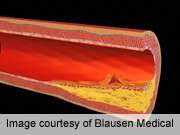Noninvasive 18F-fluoride PET can identify culprit coronary plaques

(HealthDay)—Combined positron emission tomography (PET) and computed tomography (CT) using the radioactive tracer 18F-sodium fluoride (18F-NaF) can identify ruptured and high-risk coronary plaques, according to a study published online Nov. 11 in The Lancet.
Nikhil V. Joshi, M.D., from the University of Edinburgh in the United Kingdom, and colleagues conducted a prospective clinical trial involving 40 patients with myocardial infarction and 40 with stable angina who underwent 18F-NaF and 18F-fluorodeoxyglucose (18F-FDG) PET-CT and invasive coronary angiography. The comparison of 18F-fluoride tissue-to-background ratios of culprit and non-culprit coronary plaques of patients with acute myocardial infarction was the primary end point.
The researchers found that the highest coronary 18F-NaF uptake was seen in the culprit plaque (median maximum tissue-to-background ratio: culprit, 1.66 versus highest non-culprit, 1.24) in 93 percent of the patients with myocardial infarction. Coronary 18F-FDG was generally obscured by myocardial uptake, and no differences were seen between culprit and non-culprit lesions where discernible. At the site of all carotid plaque ruptures, marked 18F-NaF occurred, which correlated with histological evidence of active calcification, macrophage infiltration, apoptosis, and necrosis. Plaques with focal 18F-NaF uptake were seen in 45 percent of patients with stable angina, and these were associated with more high-risk features on intravascular ultrasound compared with those without uptake.
"18F-NaF PET-CT is the first non-invasive imaging method to identify and localize ruptured and high-risk coronary plaque," the authors write.
One author disclosed financial ties to Abbott Diagnostics.
More information:
Abstract
Full Text (subscription or payment may be required)
Editorial (subscription or payment may be required)
Copyright © 2013 HealthDay. All rights reserved.














